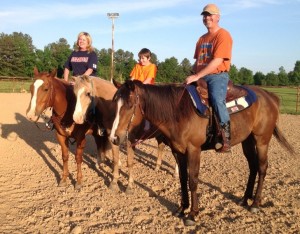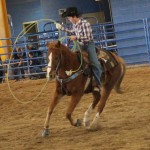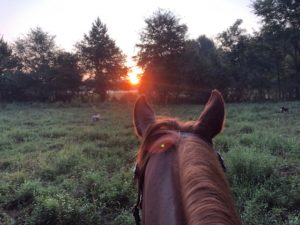 Sunday morning, I saddled Knockout for an early morning ride before church. It was a cool morning with a refreshing breeze. The ride was near perfect. Knockout was attentive and responsive, throughout.
Sunday morning, I saddled Knockout for an early morning ride before church. It was a cool morning with a refreshing breeze. The ride was near perfect. Knockout was attentive and responsive, throughout.
We checked cows, especially making sure the one-day-old calf is doing fine. Mama cow got a little defensive at our presence… and Knockout got a little tense at her defensiveness… but everyone responded calmly.
After checking cows, we repaired one section of electric fence that was down, then rode the perimeter checking fences and paying special attention to recent repair spots.
Then we finished up with a woods trail ride winding through the back corner of our property. Other than the abundance of spider webs this time of year (and the tension induced by a big spider crawling down my neck), the trail ride went smoothly.
Toward the end of the trail ride, I decided to change things up a bit. We were cutting across the corner of a pasture to the start of another trail when I decided to turn and ride off-trail through the woods.
Knockout responded well. He never balked or tried to turn aside. He went where I asked.
However, when I first turned, Knockout slowed. His steps became choppy and reluctant. He moved his head side-to-side as he cast around for a trail… a definitive direction to travel. But there was no trail. There were paths… multiple paths… with no clear destination. Knockout didn’t know where we were going. How could he know? I wasn’t sure, myself. The turn off-trail was a last minute whim.
As Knockout searched for a path, I was doing the same thing. I knew the next few steps and guided Knockout accordingly. However, I was also looking further out, trying to see where each path led. Trying to find a way through the woods without getting tangled in vines or brush piles. I don’t mind asking Knockout to step over a few logs, but prefer avoiding piles of brush. I don’t mind asking him to go under low branches where I would have to duck, but need to avoid branches too low for me to navigate from the saddle.
After the first couple of steps into the woods, Knockout relaxed, paid close attention to my cues, and carefully went exactly where I asked him to go.
While we were on trails, Knockout pretty well knew where we were headed and how to get there. He still listened to me and responded, but my cues mostly just confirmed what he already knew to do. Once we were off trail, he momentarily felt lost. He had no idea where we were going or how to get there. He had to rely completely on my prompting, step by step, turn by turn.
That little off-trail excursion was my favorite part of the whole ride. Off-trail requires each of us to trust the other at a deeper level. It requires both of us to pay closer attention to each other as well as our surroundings.
I was reminded of this recent post by my niece:
I know God got the wheel, but sometimes I think we off roading.
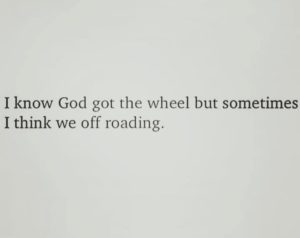 Reading her post, I chuckled at the familiarity of the feeling expressed. I have often encountered situations in life where I felt like we had left the path. Although it is a very uncomfortable feeling, each time God has proven Himself faithful.
Reading her post, I chuckled at the familiarity of the feeling expressed. I have often encountered situations in life where I felt like we had left the path. Although it is a very uncomfortable feeling, each time God has proven Himself faithful.
Right now, I have a couple of personal situations where I feel pretty lost and unsure. I’m not sure where I’m supposed to be going, much less how I am supposed to get there.
This morning I prayed:
Lord, please show me. Show me how to be a godly man in these situations. Lead me in following your will in each of these situations. Lord, please guide my steps. I feel so lost and unsure. Lord, please help me to relax and trust you. Help me to hear your voice and respond, each step of the way.
Much like Knockout, I find myself feeling very unsure, searching for the right path. Yet, also like Knockout, I know I can trust my Master to lead and guide me, step by step.
How about you? Done any off-roading (literal or metaphorical), lately?

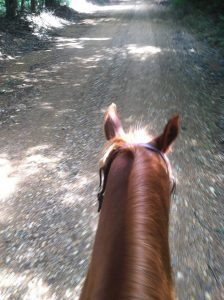 Divine direction is a difficult concept to discuss or explain. We talk about relying on the guidance of the Holy Spirit. We sing worship songs asking Jesus, “Help me, I pray. Show me the way, one day at a time.” Yet, we struggle to really explain what that means lived out in real life.
Divine direction is a difficult concept to discuss or explain. We talk about relying on the guidance of the Holy Spirit. We sing worship songs asking Jesus, “Help me, I pray. Show me the way, one day at a time.” Yet, we struggle to really explain what that means lived out in real life.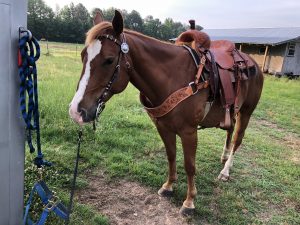 Saturday morning, Knockout and I started out on a relaxing pasture ride.
Saturday morning, Knockout and I started out on a relaxing pasture ride. I’m not an expert horse trainer. I am, at best, a novice horseman…maybe more of a wannabe horseman…which is okay, too. My only horse experience has been working with our own horses. So, take my observations with a grain of salt…I have a fairly narrow experience spectrum in regard to horse behavior.
I’m not an expert horse trainer. I am, at best, a novice horseman…maybe more of a wannabe horseman…which is okay, too. My only horse experience has been working with our own horses. So, take my observations with a grain of salt…I have a fairly narrow experience spectrum in regard to horse behavior.